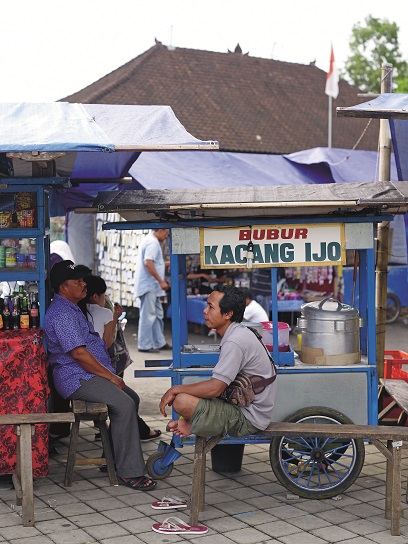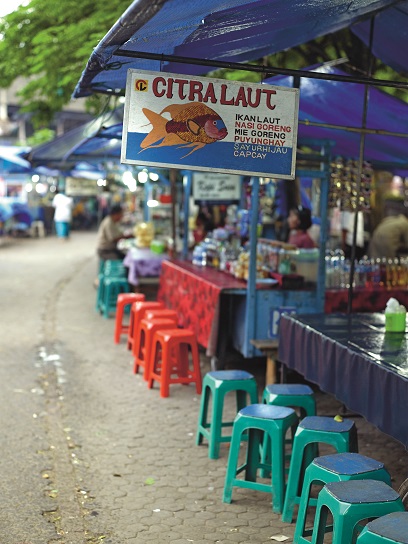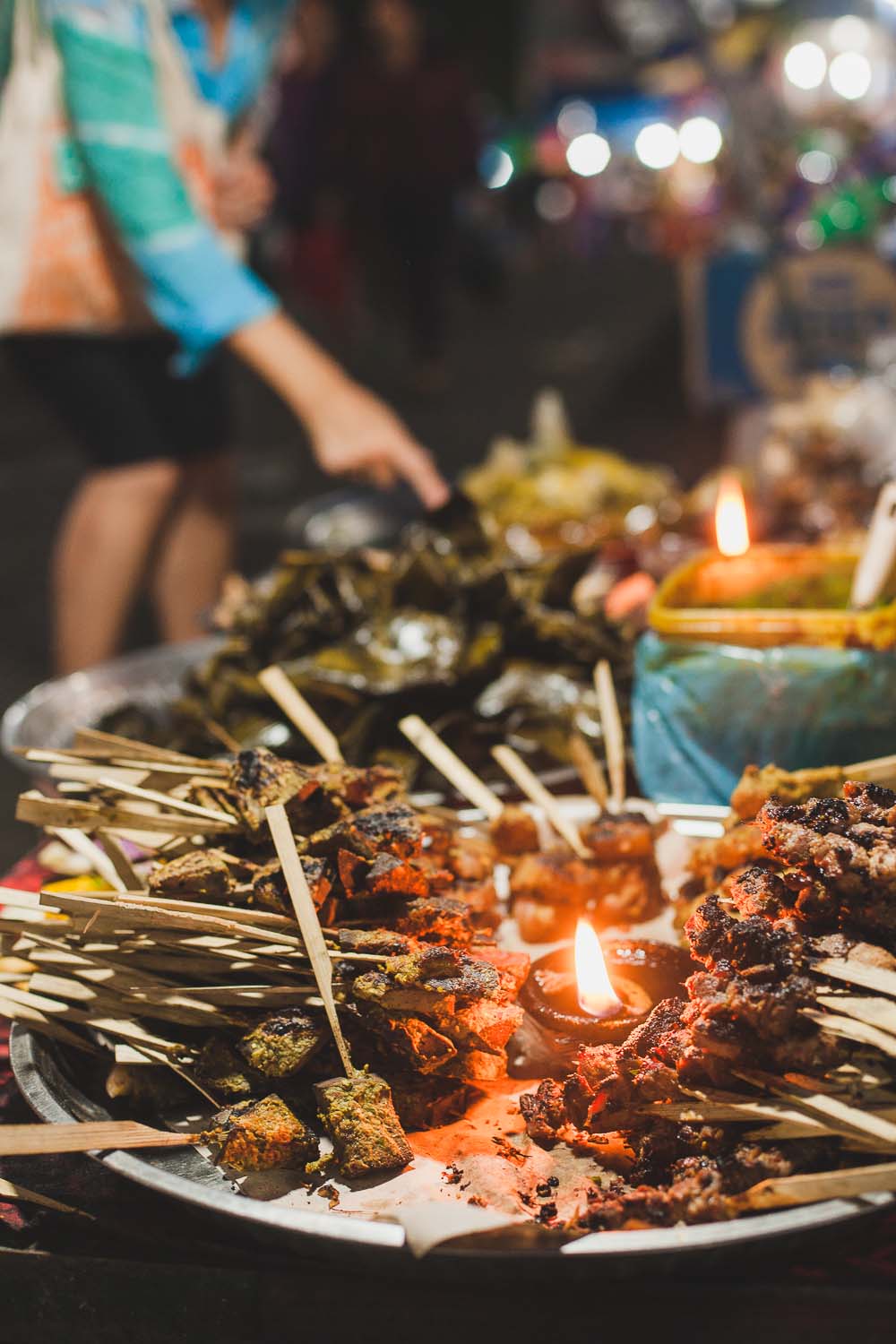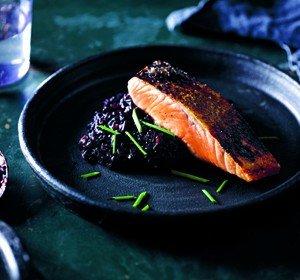Late in the afternoon, village streets across the archipelago become a moveable feast. Above the din of cars, motorbikes, children and the cranking, cooing and raucous sounds of nature, distinctive local music heralds a most comforting message – it’s time to eat. The percussion of knives, spoons, bowls, plates, glasses all become part of a culinary orchestra and as the sun starts to descend it’s on with the show as a chorus line of street vendors appears on the horizon.
I grew up in the suburbs of Melbourne. On most weekends in summer when I was young, it was the cheesy muzak of ‘Greensleeves’ that floated down the streets and it meant only one thing: Mr. Whippy. Mr. Whippy was the bearer of soft-serve, creamy white ice cream, piped to a peak into crunchy cones. It bore little resemblance to the store-bought stuff and was so associated with the strains of that traditional English folk song that like Pavlov’s dogs we all salivated at the sound of it.
And at the sight of its transport! A burlesque pink and white van with Mr. Whippy gaily painted on the front patrolled the streets enticing customers out of their houses. It was resplendent with faux ice creams in giant cones and other flashy images of sweet happiness, all of which added to the spell it cast over young gluttons like me. It literally made me weak at the knees, a state my parents were quick to exploit. “If you don’t clean up your room, there’ll be no Mr. Whippy for you”, “Finish your homework or no ice-cream”. These and other threats were part of my mother’s ammunition, her means of taming a disobedient child. She knew all the tricks and I did as I was told. No one could resist the promise of Mr. Whippy.
In Indonesia of course, the choice of street food isn’t confined to sloppy sweet desserts. The music of the vendors is more varied too, but you soon come to recognise each one. The tek-tek-tek of a knife banging on a plate is the sound of noodles, while the hollow tock-tock-tock of a stick on bamboo, means tofu. Ting-ting-ting, the ringing sound of a spoon tapping the rim of a porcelain bowl is the nationally recognised music of bakso, notes that create quite a stir in our house. Bakso time!
The streets are alive with the sound of music and I picture myself like Julie Andrews twirling on a hill, spoon and bowl at the ready, leaping towards the bakso seller and his home-made cart, a delicate barrow on old bicycle wheels, daubed in vibrant blue. The same kind of emotions that Mr. Whippy stirred in me as a child are awakened in the digestive tracts of young Indonesians every afternoon.
Well, almost every afternoon. With Ramadan over, and the Muslim Lebaran holidays underway, a curious silence has descended, and then a hunger. Bali’s own de facto fasting season has begun. The majority of street hawkers in Bali are from elsewhere, from Java mostly, and during the post-Ramadan holidays they return to their roots, to the land of their ancestors, to their own axis mundi. This leads, in turn, to the disappearance of afternoon snacks from an entire island. The streets become almost deserted and housewives start to look forlorn, forced to return to the tiring domestic duty of preparing their own snacks for themselves and their children.
The practice of home deliveries, Indonesian-style, began in Bali roughly in the 80s. That’s what happens when people move around; their cuisine moves with them. Rather like McDonalds, (which my husband Ketut affectionately refers to as the American Embassy), perhaps there is comfort in knowing that the same food and the same flavours can be found no matter where you are. But rather than setting up shop and waiting for customers to come, the purveyors of street food, with minimum capital, become mobile. So there’s no need to go out for dinner as we do in the west, although that remains an option, because food here comes to you, tracks you down no matter where you live.
Although bakso, meatball soup with noodles and trimmings, is yet another example of the influence of Indonesia’s Chinese community, it has over the generations been wholeheartedly embraced by all. Nevertheless, for some Balinese purists it remains an alien feature in the culinary streetscape because it seems that there is more to bakso than meets the palate. Enter bakso krama Bali. While bakso balls are traditionally made of chicken, or sometimes beef or goat, meat unlikely to offend most Indonesian religious sensibilities, bakso Bali is made from pork, the foodstuff that most clearly separates the Hindu Balinese from their Muslim neighbours.
Bakso Krama Bali sellers also have their own code of dress and mode of transport. The traditional jalan-jalan food cart has been replaced by a zippy motorbike and his costume is none other than a sarong and udeng, the traditional Balinese head-gear, as if he is fresh from a ceremony. The only music that accompanies him is the brrrm-brrrm-brrrm of the motorbike. After all, how could you carry about an entire Balinese gamelan on a motorbike – chang-chang-chang-kechang?
Folk on the island say that migrants come to Bali to sell bakso to buy land while the Balinese are selling land to buy bakso. They say that while Balinese bakso might be more expensive, it is more delicious because it contains fewer preservatives than that offered by the others. Who’s to know? While gastronomic cultural purity might eventually create solidarity in one arena it can also cause rumblings on other fronts.
Which brings me back to my point: where’s my afternoon bakso? Any culinary entrepreneur worth his or her salt would seize on this opportunity and grab the bull by the horns, so to speak…or the pig by the tail. But, alas, there is no brrrm-brrrm-brrrm to stir my taste buds, no handsome Balinese man on a motorbike to satisfy my pangs of hunger. So I guess I will have to do without like the rest of my local compatriots or perhaps learn to make it myself. After all, I am supposed to be a village chef. So here’s cheers to ‘Bakso Krama Casa Luna’ with its secret blend of herbs and spices. Watch out!
Jakarta Post, September 21, 2009
—
Photos by Mark Roper (the first two photos of warung kaki lima) and Amaia Maguregui (during Casa Luna Cooking School’s trip to Gianyar Night Market)











